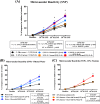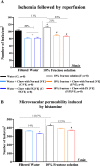α-Tocopherol Improves Microcirculatory Dysfunction on Fructose Fed Hamsters
- PMID: 26244369
- PMCID: PMC4526657
- DOI: 10.1371/journal.pone.0134740
α-Tocopherol Improves Microcirculatory Dysfunction on Fructose Fed Hamsters
Abstract
Fructose, an everyday component of western diet associated to chronic hyperglycemia and enhanced free radical production, impairs endothelial function and supplementation with antioxidants might improve it. In this study we investigated if vitamin E could reverse the microvascular damage elicited by fructose. Male Syrian golden hamsters drank either 10% fructose solution (F) or filtered water (C), combined with three concentrations of vitamin E in their chows [zero, normal (VE) or 5X (5XVE)] during 60 days. Microvascular reactivity in response to topical application of acetylcholine (Ach; endothelium-dependent vasodilator) or sodium nitroprusside (SNP; endothelium-independent vasodilator) and macromolecular permeability increase induced by either 30 min ischemia followed by reperfusion (I/R) or topical application of histamine (5 μM) were assessed using the cheek pouch preparation. Compared to controls (drinking filtered water), fructose-drinking animals showed decreased vasodilatation to acetylcholine in all concentrations tested (-56.2% for 10-9M, -53.9% for 10-7M and -43.7% for 10-5M). On the other hand, vitamin E supplementation resulted in increased responses for both water and fructose drinking groups (177.4% for F vs. F/5XVE and 241.6% for C vs. C/5XVE for 10-5M Ach). Endothelial-independent vasodilatation explored by topical application of SNP was restored and even enhanced with the supplementation of 5X vitamin E in both groups (80.1% for F vs. F/5XVE; 144.2% for C vs. C/5XVE; 3.4% of difference for C/5XVE vs. F/5XVE on 10-5M SNP). The number of leaky sites after I/R and histamine stimuli in vitamin E supplemented animals decreased (-25.1% and -15.3% for F vs. F/5XVE; and -21.7% and -16% of leaky sites comparing C vs. C/5XVE, respectively for I/R and histamine stimuli) pointing to tightening of the endothelial barrier for macromolecular permeability. Our results strongly suggest that vitamin E could improve the endothelial function and permeability barrier and also reverse impairments elicited by sugar overload.
Conflict of interest statement
Figures




Similar articles
-
Microcirculatory effects of zinc on fructose-fed hamsters.Nutr Metab Cardiovasc Dis. 2016 Apr;26(4):310-7. doi: 10.1016/j.numecd.2015.11.006. Epub 2015 Dec 7. Nutr Metab Cardiovasc Dis. 2016. PMID: 26817936
-
Effects of Selenium in the Microcirculation of Fructose-Fed Hamsters.J Vasc Res. 2018;55(4):203-209. doi: 10.1159/000489957. Epub 2018 Jul 12. J Vasc Res. 2018. PMID: 30001541
-
Aerobic exercise improves microvascular dysfunction in fructose fed hamsters.Microvasc Res. 2014 May;93:34-41. doi: 10.1016/j.mvr.2014.02.012. Epub 2014 Mar 5. Microvasc Res. 2014. PMID: 24613419
-
[Effect of vitamin E on the endothelial function of the regenerated aorta in rats following direct arterial injury].Ann Chir. 1996;50(8):673-81. Ann Chir. 1996. PMID: 9035442 Review. French.
-
The hamster cheek pouch as a model in microcirculation research.Eur Respir J Suppl. 1990 Dec;12:595s-600s; discussion 600s-601s. Eur Respir J Suppl. 1990. PMID: 2076153 Review.
References
-
- (2004) Standards of medical care in diabetes. Diabetes Care 27 Suppl 1: S15–35. - PubMed
-
- (2004) Diagnosis and classification of diabetes mellitus. Diabetes Care 27 Suppl 1: S5–s10. - PubMed
-
- Alberti KG, Zimmet PZ (1998) Definition, diagnosis and classification of diabetes mellitus and its complications. Part 1: diagnosis and classification of diabetes mellitus provisional report of a WHO consultation. Diabet Med 15: 539–553. - PubMed
-
- Fiorentino TV, Prioletta A, Zuo P, Folli F (2013) Hyperglycemia-induced oxidative stress and its role in diabetes mellitus related cardiovascular diseases. Curr Pharm Des 19: 5695–5703. - PubMed
Publication types
MeSH terms
Substances
LinkOut - more resources
Full Text Sources
Other Literature Sources
Medical

